 Loading... Please wait...
Loading... Please wait...- CALL US ON 587 987 4414
- Items / $0.00
Categories
- Home
- Ammolite Buyer's Information
Ammolite Buyer's Information
Categories
AMMOLITE FROM CANADA
THE RAREST AND MOST BEAUTIFUL GEM ON THE PLANET.
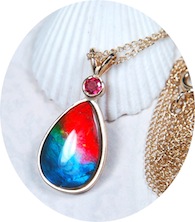
Millions of years ago, North America did not exist as we know it now. Instead there was a huge sea that cut most of modern North America in half, north to south.
In this sea roamed the ancient Ammonite, a squid like creature that lived in a shell shaped much like a ram’s horn much like todays Nautilus shell.
Geologic records show that this creature lived from 100 million years ago until about 70 million years ago at which time some unknown event caused their extinction. This inland sea bed was littered with the detritus from the shells of Ammonites which were gradually covered by sediments and then subjected to all the pressures that deeply buried materials go through in the process of forming rock and fossils.
Now, the ancient ammonite existed all over the world prior to its extinction and much of it would be preserved as rather dull coloured fossils with a bit of colour shine and would be unearthed as such in many spots around the globe.
In one tiny spot in Canada, in the province of Alberta near the majestic Rockies and just north of the Montana border, there was something special about the Ammonites sleeping in the shale along the St Mary River. Nature had, with the help of just the right combinations of pressure, heat, time and minerals, created the rarest and amazingly coloured and beautiful precious stone in the world.
These Ammonites had fossilized and merged with their host shale rock host to create the most colourful and varied gem material on the planet.
And only in this one small spot in the world can top grade gem quality Ammolite be found!
Man had discovered the stone earlier on as ancient aboriginal legends tells of how the stone had mighty hunting powers associated with it. Ancient hunters added it to their talismans to make sure that they could locate and successfully hunt buffalo.
The beauty of Ammolite was noted by early explorers but it wasn’t until the 1980’s that local Alberta entrepreneurs realized that this stone was of gem quality and efforts got under way to mine and process it as actual gem stones for jewelry. In 1981 ammolite was recognized as such by the CIBJO [Coloured Stones Commission] and in 1985 by the province of Alberta as its official gemstone.
The world’s rarest and most beautifully coloured gemstone had arrived and it was to be known as Ammolite.
Today there are only two recognized and legal gem mining companies in operation, both produce fine gem ammolite. There are also fine Ammolite gems produced by a small group of individuals who have legal claims operating in the gem zone although their production is quite small.All of these production sites are within a few miles of my home.
Ammolite is mined by small open pit mining operations where the material is unearthed and sorted literally by hand. Most of the material is lower quality unsuitable as gem material and only a small fraction of that is gem quality and makes it to the final stage as fine gem ammolite.
There is a market for the lower quality ammolite of which there is a far greater supply and,naturally is priced much lower. Easily recognizable by its less varied colour and brilliance.Orange and green are common in lower grades however but they are still very attractive and of interest to budget buyers.
There are also those selling cheap whole or sliced common fossil ammonites from places such as Madagascar and wrongfully describing them as Ammolite--do not be fooled by this!
Top grade gem Ammolite is in very short supply and once the diggings along the St.Mary area are exhausted, there is no other known commercially viable gem quality material deposits known to exist.
Ammolite is known as one of the rarest gems in the world due to the fact that less than 10 acres of prospect are processed each year and of that rough product less than 5% makes it to top grade jewelry.
This limited supply has created upward pressure on prices. The main producer, Korite International reports that Ammolite prices have increased by 250% in the 10 years to 2008 and much more since then.
Ammolite has a curious effect on humans the first time they see it and only a small fraction of humanity has seen it so far. Many just have to possess it! Few can ignore it!
Ammolite Colours
One of the attractions of ammolite is its amazing range of colours--some quite common such as green and orange and some rarer such as shades of blue and cherry red.Then there are the very rare shades of pink,mauve and purple. There are those gems named in the trade as "collector" gems.While this is not a formal grade it denotes a gem exceedingly rare for its number of colours and pattern.Prices of course can vary depending on colour and rarity.
Colour shifting is another characteristic of ammolite.Gems can display totally different colours simply by moving it.Some gems have this to a greater degree than others.
Ammolite and “Feng shui”
One of the largest demands on the Ammolite supply is from Asia where buyers value the stone for its beauty but increasingly also because of its Feng Shui properties
"The Most Influential Stone of the Millenium”---says Feng Shui Master Edward Kui Ming Li
Feng Shui masters have named Ammolite:
“The Seven Colour Prosperity Stone”.
“It has been buried for the past 71 million years absorbing a substantial amount of both the Earth’s and the universe’s positive cosmic energy. It radiates this energy in every colour of the visible spectrumenhancing well-being and reducing the body’s toxicity of those that own it”
Each colour has a different meaning in Feng Shui:
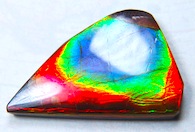
Crimson generates growth and energy; orange stimulates creativity, and increased libido; Green improves wisdom, intellect and promotes entreprenerialship; Yellow provides wealth; and Blue promotes health and peace.
Feng Shui practitioners believe that: “Not only does it bring balance to a person’s body, but also to a person’s environment. When it is worn or when the stone is placed in the home, it helps create a happy family, and when it is placed in the work place, it promotes good business dealings. In essence, those who possesses Ammolite areentitled to increased prosperity and good fortune.
Don’t believe in Feng Shui? ----That’s Fine! ----- Many folks own Ammolite just for it’s rarity and beauty!
Some folks are creating Ammolite collections for investment purposes against the fact that Ammolite is becoming a rarer commodity every day.
Once current supplies are depleted,no commercially viable deposits are known to exist.
This situation is believed to be why prices of quality Ammolite has risen so dramatically over the last decade and continues to do so today.
Ammolite comes in many forms--Learn what they are.
Ammolite for jewelry takes many different forms for different purposes and this fact causes much confusion for buyers who do not understand how and why different forms are valued so differently.
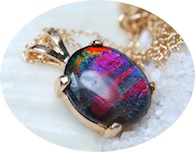
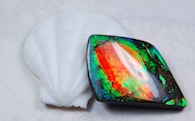
CARING FOR YOUR AMMOLITE
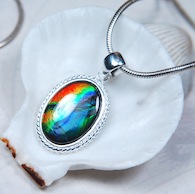
Ammolite is an organic gemstone so treat it much as you would opals or pearls. Clean only with a damp cloth--no abrasives or solvents. Do not immerse in water for long periods. Avoid sharp shocks. Never use a sonic cleaner.
Triplets have hard caps usually of quartz but may delaminate if subjected to serious pressure,intense heat or prolonged immersion.
Natural gemstones may or may not have a protective layer of epoxy on them.
In either case observe cautions above with the addition caveat--don't drop your natural on a hard surface as it may shatter.I have lost a few by dropping them on a hard surface--which is now carpeted!
Care for your ammolite properly and it will last forever.